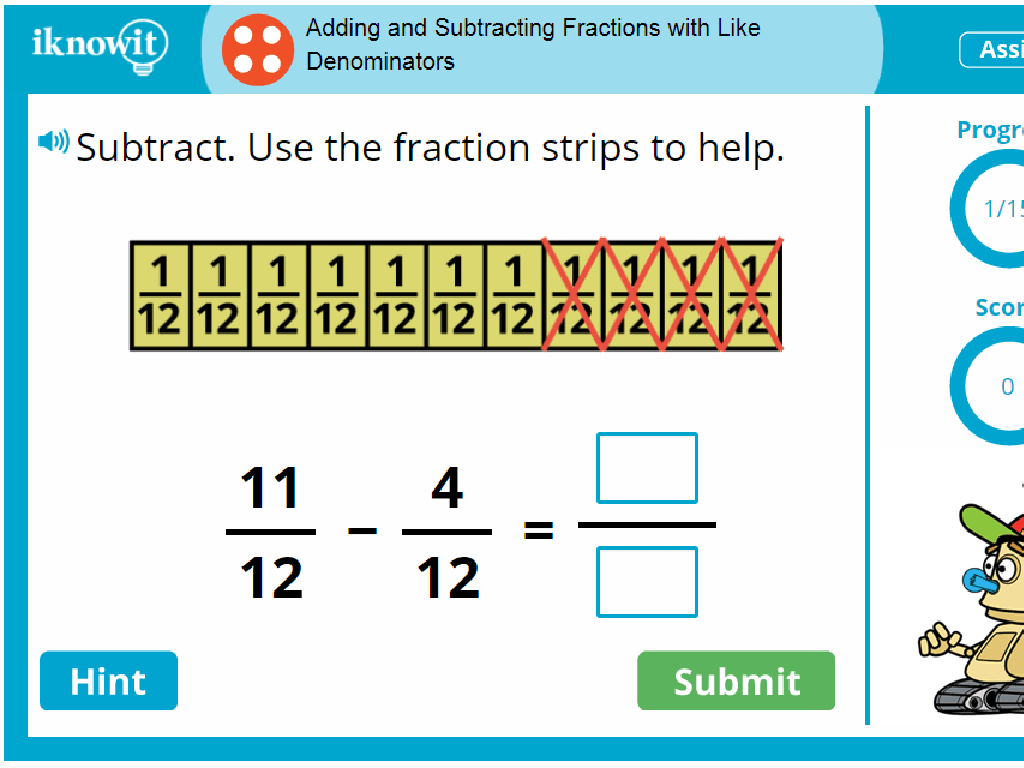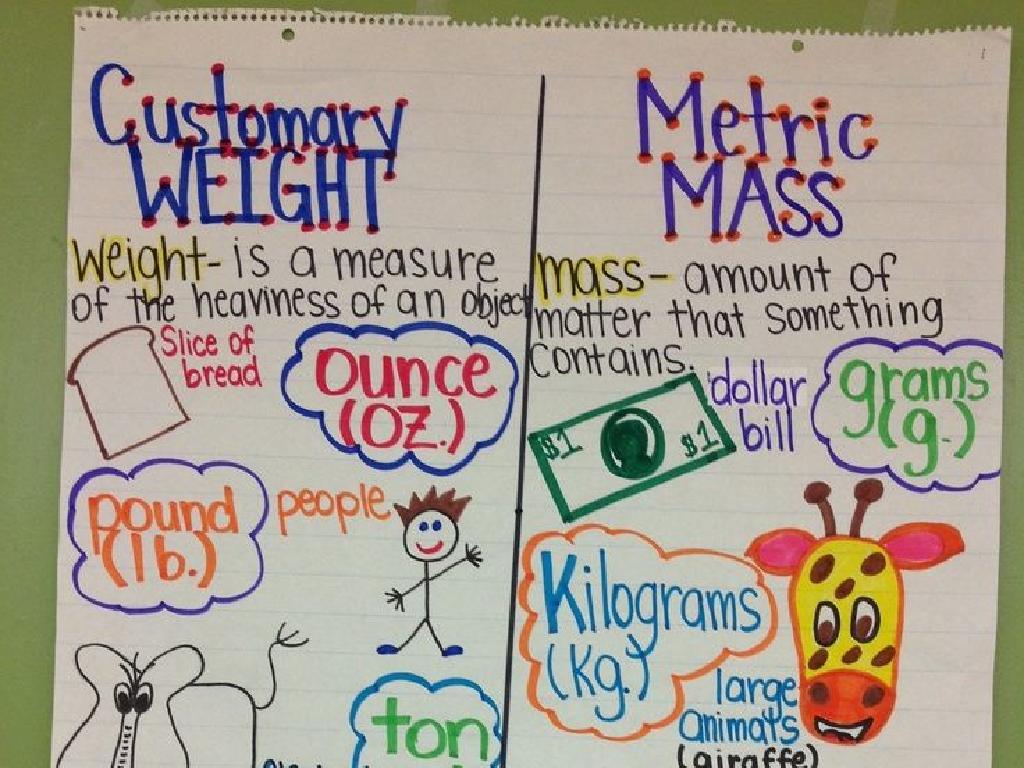Compare Numbers Up To 10 Using Symbols
Subject: Math
Grade: First grade
Topic: Comparing Up To 10
Please LOG IN to download the presentation. Access is available to registered users only.
View More Content
Welcome to Comparing Numbers!
– Learn to compare numbers
– Understand greater and less than
– Which number is bigger, 2 or 5?
– Symbols: >, means more, < means less, = means the same
– Become a Number Detective
– Use clues to compare numbers like a detective
|
This slide introduces first graders to the concept of comparing numbers up to 10. Start by explaining that comparing numbers is like being a detective, looking for clues to decide which number is bigger, smaller, or if they are the same. Introduce the symbols for greater than (>) and less than (<), and equal to (=). Use simple examples to demonstrate how to use these symbols when comparing two numbers. Encourage the students to think of the symbols as a crocodile's mouth that always wants to eat the bigger number. This visual can help them remember which way the symbol should face. Prepare to engage the students with hands-on activities where they can practice using these symbols to compare numbers.
Learning to Compare Numbers
– What does ‘compare’ mean?
– Comparing is checking if things are the same, or different in amount.
– We compare things every day!
– Like choosing between toys or books, which one has more?
– Comparing numbers up to 10
– Using symbols like >, <, = to see which number is bigger or smaller.
– Discover bigger or smaller numbers
– Look at two numbers and decide which one is greater or less.
|
This slide introduces the concept of comparison to first graders. Start by explaining that to compare means to evaluate how things are similar or different. Use relatable examples like comparing the number of toys or books they have to make the concept tangible. Then, transition to comparing numbers, emphasizing that we can use symbols like greater than (>) and less than (<) to show which number is bigger or smaller. Encourage students to think of numbers as quantities that can be measured against each other, and introduce the equal sign (=) as a way to show when two numbers are the same. Use hands-on activities with physical objects to demonstrate comparison in a way that's engaging and understandable for young learners.
Meet the Symbols!
– ‘Greater than’ symbol: >
– Think of > as a hungry alligator that wants to eat the bigger number!
– ‘Less than’ symbol: , but < faces the smaller number.
– 'Equal to' symbol: =
– Two lines mean both numbers are the same size.
|
This slide introduces first graders to the basic comparison symbols used in math to compare numbers up to 10. The ‘greater than’ symbol (>) can be visualized as a hungry alligator that always wants to eat the larger number, which helps students remember that the open end faces the bigger number. The ‘less than’ symbol (<) is the opposite, facing the smaller number. The 'equal to' symbol (=) represents balance, indicating that the numbers on either side are the same. Use real-life examples like snack quantities or toy counts to illustrate these concepts. Encourage students to draw their own alligators and practice comparing numbers with their classmates.
Understanding ‘Greater Than’
– ‘Greater than’ means bigger
– Symbol for ‘greater than’ is >
– Example: 7 > 5
– Seven is more than five
– Alligator eats the bigger number!
– Imagine > as an alligator’s open mouth
|
This slide introduces the concept of ‘greater than’ to first graders. Start by explaining that when we compare two numbers, we can tell if one number is bigger or smaller than the other. The ‘greater than’ symbol (>) is used when one number is bigger. For example, 7 is bigger than 5, so we write it as 7 > 5. To make it fun and memorable, use the analogy of an alligator that always wants to eat the bigger number, so the open mouth of the alligator (>) faces the larger number. Encourage the students to draw their own alligators with the open mouth facing the bigger number in different examples.
Understanding ‘Less Than’ Symbol
– ‘Less than’ symbol: <
– Comparing two numbers
– Decide which number is smaller
– Example: 3 < 8
– Three is smaller than eight
– Alligator eats the bigger number!
– The open mouth of < always points to the smaller number
|
This slide introduces the ‘less than’ symbol and how it is used to compare two numbers. Explain that the ‘less than’ symbol (<) looks like a hungry alligator that always wants to eat the bigger number. Use the example 3 < 8 to show that three is smaller than eight, and therefore the alligator's mouth is open towards the eight. Encourage students to think of the symbol as an alligator's open mouth to help them remember. Practice with more examples, and remind them that the alligator always 'eats' the larger number, which helps them understand the concept of comparing sizes of numbers up to 10.
Understanding ‘Equal To’ in Numbers
– ‘Equal to’ means the same as
– Use ‘=’ for numbers that match
– Example: 4 = 4 means both are same
– Like two identical apples, one on each side
– Think of ‘=’ as a balance scale
– When both sides of ‘=’ have the same amount, it’s balanced
|
This slide introduces the concept of equality using the ‘equal to’ symbol. It’s crucial for first graders to understand that the ‘=’ sign represents a balance between two numbers. Use everyday examples, such as comparing two sets of the same number of objects, to illustrate this point. Encourage students to visualize the ‘=’ sign as a balance scale where both sides need to have the same weight (or amount) to be equal. Reinforce this concept with hands-on activities where students can use physical objects to create equal groups and write corresponding equations.
Let’s Practice Comparing Numbers!
– Compare with symbols: >, , , <, or = 7?
– 2 is less than 7, so we use ,
|
This slide is an interactive class activity designed to help first graders understand and practice comparing numbers using the greater than (>), less than (<), and equal to (=) symbols. Start by explaining each symbol and what it represents. Then, present the comparisons one by one, asking the class to decide the correct symbol for each pair of numbers. Encourage students to explain their reasoning. For the activity, you can have students draw their own number comparisons, use physical objects to visualize the quantities, or work in pairs to quiz each other. The goal is to ensure that by the end of the lesson, each student can confidently compare numbers up to 10 using the correct symbols.
Class Activity: Number Line Friends
– Create a number line with friends
– Stand in order from 1 to 10
– Use comparison symbols
– Symbols like >, 3′ means 4 is greater than 3
|
This interactive class activity is designed to help first graders understand the concept of comparing numbers using symbols. Each student will be assigned a number between 1 and 10 and will then stand in the correct order to form a human number line. Once in order, students will use ‘greater than’ (>), ‘less than’ (<), or 'equal to' (=) signs to compare their numbers with their neighbors. For example, a student with the number 5 will stand to the right of the student with the number 4 and to the left of the student with the number 6, demonstrating that 5 is greater than 4 and less than 6. This visual and physical representation of number comparison will help solidify the concept. The teacher should prepare signs for the comparison symbols and guide the students through several rounds of comparison to ensure understanding.
Becoming Comparison Experts!
– Congratulations, Number Detectives!
– Mastered comparing with symbols
– You can use , and = to compare numbers
– Keep practicing your skills
– The more you practice, the better you’ll get
– Aim to be a comparison expert!
|
This slide is meant to congratulate the students on learning how to compare numbers up to 10 using the less than (), and equal to (=) symbols. It’s important to encourage them to continue practicing these skills to reinforce their understanding. As they become more familiar with comparison, they will be able to quickly determine the relationship between numbers. Celebrate their achievements in this lesson and motivate them to keep working towards becoming comparison experts. You can suggest playing number comparison games at home or with friends to make practice fun and engaging.






